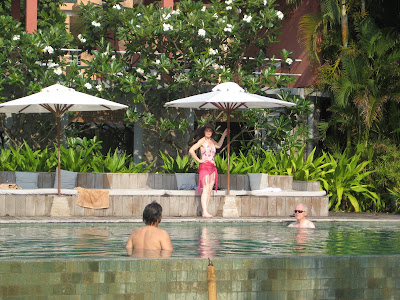

There was mix-up over our itinerary and the guide thought we just had a half day booked. I produced the relevant paperwork about our afternoon cyclo tour and, fair play to him, he got it all sorted out and 5 men turned up on pushbikes with Victorian perambulator-style attachments for us to sit in. It was so hot and the men were so skinny that I felt sorry for them having to pedal us around all afternoon. Ian made a joke about who was going to get the big guy and once our guide translated there was much joshing around. The Cambodians seem to be such straightforward, unaffected people and all it took was a little light humour from us and a convivial atmosphere was set up for the afternoon. This was lucky, as our lives were in their hands! My goodness, the roads were busy with everything from livestock to fast cars. The highway code was a little different to ours - nobody worries about what's behind and well, it all seemed to be based on a game of chicken! We were crossing 3 lanes of fast traffic with no more indication than a gently waving hand and no more acceleration than a flattened flip-flop and yet it was fun. I had that holiday feeling. I was off-the-leash, unfettered and (almost literally) laid-back.
 |
| The Silver Pagoda |
Our first stop was the Royal Palace and Silver Pagoda, the home of King Norodom Sihamoni. Thankfully this complex was granted dispensation by the Khmer Rouge, although many of the treasures were looted. It was all very beautiful - gold, jewels, fine costumes, beautiful pagodas - just how Siam looked in The King and I! The centrepiece of the Silver Pagoda is a 17th century emerald Buddha statue and in front of that a 90kg golden Buddha, conforming to the vital statistics of King Norodom and studded with 9584 diamonds.


Next stop the national museum; a colourful tropical building that housed some interesting pieces, dated and explained, as is the way with museums. I'm glad that a selection of statues and sculptures are being kept safely indoors as so many in Angkor Wat and other temples are being stolen, beheaded and defaced. However, the statues in the museum didn't have half the impact as those in situ.
One mystery was solved! They had lingas, and when you look at them from the correct angle they do indeed look phallic. It's all to do with perspective (Richard has explained that to me before). Viewed from above, for example if they are on a riverbed, they look like roundabouts, but NOW we can see what all the fuss is about.
Our cyclo men took us home along the Mekong River and from the comfort of our pram we could see and feel the mood of the Cambodian capital. The French Cafes, markets, boutiques, orange clad monks, moped madness and chickens scratching about, all fused together in a magical melting pot. OMG - are we about to go the wrong way around this roundabout? Yessum.


Back at the hotel we enjoyed a cool dip in the pool. Even though we are in the very centre of a busy town, the hotel has been exceptionally well-designed and has a secluded 'secret garden' feel about it. Unfortunately the fact that no food or drink is being served is a complete let-down. We have been told that it is Cambodian New Year and the staff are on leave. Huh? And in any case, surely the guy at reception could open a bottle of something? One good outcome is that we have no choice but to venture out for our evening meal. Phonm Penh has seemed very safe and friendly to us, but we surmise from the guards and barbed wire around the buildings we pass that things are not all they seem. We were lucky enough to be within a few minutes of the very fancy
Malis restaurant , which has a reputation for fine dining and contemporary Cambodian cuisine and was featured in
Gordon Ramsay's Great Escapes on Chanel 4. We hadn't realised this, so imagine our surprise to see a photo of the man himself stuck right the middle of the restaurant. I enjoyed a scrumptious Langoustine and Tamarind juice with Wok Fried Morning Glory. Mmm - mmm. Louise and Ian were in heaven with their decent cup of coffee.
MARKS OUTTA 10
Louise: The cyclo ride along the river and the Coronation Room at the Royal Palace are worth a special mention. The problem today was the muddle over the itinerary. 7/10
Richard: The cyclo bike ride was the best thing today but the museum was a pain in the neck - I've seen enough statues to last a lifetime. 7/10
Ian: I found the photos at S21 very interesting as each face carried so much emotion. The cyclos were great as they gave me lots of opportunities to take traffic photos. The problem today was the museum - dull, dull, dull. 9/10
Jackie: I feel that the memorial stupa at Choeng Ek was a fitting expression of remorse and respect. The violence and depravity of the Killing Fields and S21 contrasted dramatically with the wealth and splendour of the Royal Palace - a perfect example of the out-of-the-ordinary one sees when travelling. The hotel is letting itself down badly on service. 8/10



















